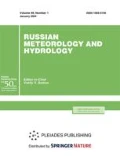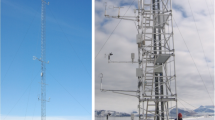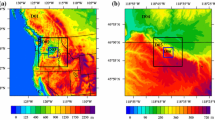Abstract
A method to forecast orographic turbulence basing on the COSMO-Ru7 numerical model output data is presented. The calculation algorithm represents the critical amplitude approach for gravity waves and allows identifying zones of mountain wave breaking that generate turbulence. Its intensity is estimated through the wave drag value. The calculation is based on the model data for the territory of European Russia for April–September 2019. Its results obtained from forecast data are in a good agreement with those from initial model data for the forecast time. The turbulent zones are more intense at night than in the daytime and are situated over obstacles (for example, over the Crimean and Ural mountains) and on their lee slopes, in accordance with the physics of the phenomenon.



Similar content being viewed by others
REFERENCES
D. V. Blinov and G. S. Rivin, “The COSMO-Ru Short-range Nonhydrostatic Mesoscale Weather Prediction System,” Trudy Gidromettsentra Rossii, No. 365 (2017) [in Russian].
S. V. Borisova, Mesoscale Circulations in Mountains (Ekologiya, Odessa, 2013) [in Russian].
E. A. Burman, Local Winds (Gidrometeoizdat, Leningrad, 1969) [in Russian].
A. A. Vasil’ev, “On the Problem of the Scorer’s Parameter Application to the Turbulence Forecasting on the Lee Side of Mountains,” Trudy TsIP, No. 158 (1966) [in Russian].
A. A. Vasil’ev, “Wind Distribution over the Crimean Mountains and Specific Features of Helicopter Turbulence under Different Synoptic Conditions,” Trudy GGO, No. 171 (1965) [in Russian].
N. K. Vinnichenko, N. Z. Pinus, S. M. Shmeter, abd G. N. Shur, Turbulence in the Free Atmosphere (Gidrometeoizdat, Leningrad, 1976) [in Russian].
L. S. Minina, Practice of Nephanalysis (Gidrometeoizdat, Leningrad, 1970) [in Russian].
M. A. Petrosyants, S. G. Chanysheva, and O. I. Subbotina, “On the Scale of Orographic Effects on Meteorological Processes in Central Asia,” Trudy SARNIGMI, No. 19 (1974) [in Russian].
N. P. Shakina, Hydrodynamic Instability in the Atmosphere (Gidrometeoizdat, Leningrad, 1990) [in Russian].
N. P. Shakina, “Orographic Turbulence: Generation Mechanisms and Forecasting,” Gidrometeorologicheskie Issledovaniya i Prognozy, No. 1 (2019) [in Russian].
N. P. Shakina and G. V. Khomenko, “Gravity Waves in Nonstationary Flows,” Trudy TsAO, No. 112 (1973) [in Russian].
N. P. Shakina, G. V. Khomenko, and A. A. Vasil’ev, “Effects of Airflow Stratification and Parameters of Internal Waves on the Occurrence of Clear Air Turbulence,” Trudy Gidromettsentra SSSR, No. 235 (1980) [in Russian].
H. Agustson and H. Olafsson, “Simulation of Observed Lee Waves and Rotor Turbulence,” Mon. Wea. Rev., 142 (2014).
J. T. Bacmeister, P. A. Newman, B. L. Gary, and H. R. Chan, “An Algorithm for Forecasting Mountain-wave Related Turbulence in the Stratosphere,” Wea. Forecast., 9 (1994).
F. P. Bretherton, “Momentum Transport by Gravity Waves,” Quart. J. Roy. Meteorol. Soc., 95 (1969).
J. D. Doyle, D. R. Durran, B. A. Colle, C. Chen, M. Georgelin, V. Grubisic, W. R. Hsu, C. Y. Huang, D. Landau, Y.-L. Lin, G. S. Poulos, W. Y. Sin, D. R. Weber, M. G. Wurtell, and M. Xue, “An Intercomparison of Model Predicted Wave Breaking for the 11 January 1972 Boulder Windstorm,” Mon. Wea. Rev., 128 (2000).
D. R. Durran, “Another Look at Downslope Wind Storms. Part I. The Development of Analogs to Supercritical Flow in an Infinitely Deep, Continually Stratified Fluid,” J. Atmos. Sci., 43 (1986).
C. C. Epifanio and D. R. Durran, “Lee-vortex Formation in Free-slip Stratified Flow over Ridges. Part 1: Comparison of Weakly Nonlinear Inviscid Theory and Fully Nonlinear Viscous Simulation,” J. Atmos. Sci., 59 (2002).
Q. Jiang and J. D. Doyle, “Gravity-wave Breaking over the Central Alps: Role of Complex Terrain,” J. Atmos. Sci., 61 (2004).
J.-H. Jung, “Simulation of Orographic Effects with a Quasi-3D Multiscale Modeling Framework: Basic Algorithm and Preliminary Results,” J. Adv. Model. Earth Syst., 8 (2016).
L. Li and P. W. Chan, “Numerical Simulation Study of the Effect of Buildings and Complex Terrain on the Low-level Winds at an Airport in Typhoon Situation,” Meteorol. Z., 21 (2012).
D. K. Lilly, “A Severe Downslope Windstorm and Aircraft Turbulence Event Induced by a Mountain Wave,” J. Atmos. Sci., 35 (1978).
D. K. Lilly and E. L. Zipser, “The Front Range Windstorm of January 11, 1972,” Weatherwise, 25 (1972).
D. W. McCann, “Diagnosing and Forecasting Aircraft Turbulence with Steepening Mountain Waves,” Nat. Wea. Digest, 20 (2006).
N. A. McFarlane, “The Effect of Orographically Excited Gravity-wave Drag on the General Circulation of the Lower Stratosphere and Troposphere,” J. Atmos. Sci., 54 (1987).
J. W. Miles, “On the Stability of Heterogeneous Shear Flow,” J. Fluid Mech., 10 (1981).
T. N. Palmer, J. Shutts, and R. Swinbank, “Alleviation of Systematic Westerly Bias in General Circulation Models through an Orographic Gravity Wave Drag Parameterization,” Quart. J. Roy. Meteorol. Soc., 112 (1986).
W. R. Peltier and T. L. Clark, “The Evolution and Stability of a Finite-amplitude Mountain Wave. Part II. Surface Drag and Severe Downslope Winds,” J. Atmos. Sci., 36 (1979).
C. Schor and R. B. Smith, “Shallow-water Flow Past Isolated Topography. Part 1. Vorticity Production and Wake Formation,” J. Atmos. Sci., 50 (1993).
R. B. Smith, “The Steepening of Hydrostatic Mountain Waves,” J. Atmos. Sci., 34 (1977).
L. Strauss, S. Serafin, S. Haimov, and V. Grubisic, “Turbulence in Breaking Mountain Waves and Atmospheric Rotors Estimated from Airborne in Situ and Doppler Radar Measurements,” Quart. J. Roy. Meteorol. Soc., 141 (2015).
H. Wells and S. B. Vosper, “The Accuracy of Linear Theory for Predicting Mountain-wave Drag: Implications for Parametrization Schemes,” Quart. J. Roy. Meteorol. Soc., 136 (2010).
Author information
Authors and Affiliations
Corresponding author
Additional information
Russian Text ©The Author(s), 2021, published in Meteorologiya i Gidrologiya, 2021, No. 1, pp. 40-52.
About this article
Cite this article
Shakina, N.P., Skriptunova, E.N. & Zav’yalova, A.A. Orographic Turbulence Forecasting from Numerical Model Output Data. Russ. Meteorol. Hydrol. 46, 28–36 (2021). https://doi.org/10.3103/S1068373921010040
Received:
Revised:
Accepted:
Published:
Issue Date:
DOI: https://doi.org/10.3103/S1068373921010040




